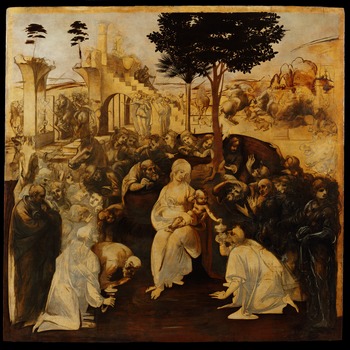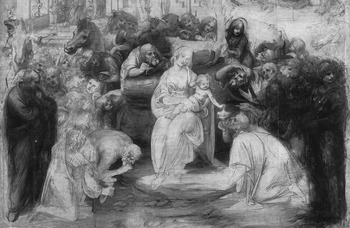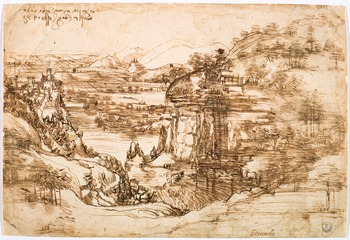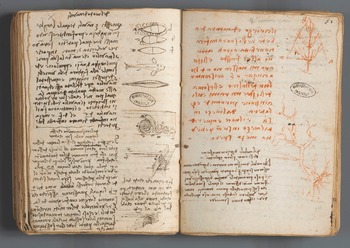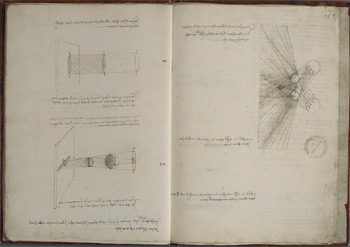Leonardo da Vinci studies are in effect two different—almost antagonistic—domains: a narrowly defined field that is so specialized that it scares scholars away (it takes years of dedicated work to learn how to deal with Leonardo's legacy), and a phenomenon of popular culture that is so massive that news about the artist's works makes headlines worldwide. Both aspects of Leonardo studies—the specialized scholarship and the vast public interest—grew exponentially in the past few decades and exploded in 2019, the year that marked the 500th anniversary of the artist's death. Although they only rarely come together, their convergence may offer the best hope for the future of Leonardo studies. Indeed, the recent anniversary provided a reminder that Leonardo da Vinci still touches the imagination of scholars and the general public in ways that force us to ask what is it that connects to our current age. Why is the study of this master of visualization, who made visible what could not be seen—vessels, muscles, water vortexes, wind, the intentions of people's minds—in diagrams, maps, sketches, figurative images, and paintings, significant for the current historical moment? Can we learn something from Leonardo studies—and, more broadly, from Renaissance studies, of which Leonardo studies are a part—as we struggle to find new frameworks to teach, research, innovate, and communicate with one another, or, to quote the mission statement of the Andrew W. Mellon Foundation, “to build just communities enriched by meaning and empowered by critical thinking, where ideas and imagination can thrive”?Footnote 1
Myriad events that stretched well beyond the twelve months of the anniversary year were planned worldwide, from major exhibitions at the Louvre, the Uffizi, the Queen's Gallery at Buckingham Palace, the Sforza Castle in Milan, and the National Gallery in Washington, DC, to smaller exhibitions in the artist's native town of Vinci, at the country house in the Loire Valley where he died, and in the village of Anghiari, where a famous battle he planned to paint took place. Music was written in his honor, from a chamber opera by composer Jonathan Berger to songs by guitar legend Carlos Santana. The Royal Mail issued stamps featuring Leonardo's drawings. The Salone del Mobile, in Milan, presented site-specific installations inspired by Leonardo's drawings on water. The Accademia del Profumo, in Venice, organized a small exhibition on Leonardo e i profumi.
Museums around the world showcased their Leonardo holdings and experimented with new forms of exhibition. Martin Clayton, head curator of Prints and Drawings at Windsor Castle, organized an innovative one in order to reach the largest possible audience. His exhibition was a series of twelve simultaneous events across the United Kingdom, each venue featuring twelve drawings, for a total of 144 of Leonardo's greatest drawings, selected from the Royal Collection's impressive holdings; the events culminated in a final display of all the works (plus some others) at the Queen's Gallery. With a similar scope of reaching a wide public, Barbara Jatta, director of the Vatican Museums, had Leonardo's Saint Jerome, which usually hangs in the Pinacoteca Vaticana, through which very few among the roughly million people who visit the museum every year pass, moved to the more accessible Braccio di Carlo Magno, off Saint Peter's square (later in the year the painting was exhibited at the Metropolitan Museum of Art and the Louvre). Pietro Marani, who had co-curated, with Maria Teresa Fiorio, a major exhibition on the artist in 2015, in conjunction with the Universal Exposition in Milan, focused on a less known but highly significant work by Leonardo, the so-called Scapigliata, in an exhibition he co-curated with Simone Verde in Parma, and on the Madonna Litta from the Hermitage in another exhibition he co-curated, with Andrea De Lorenzo in Milan. Bill and Melinda Gates loaned the entire Codex Leicester, which they own, to the Uffizi for the inaugural exhibition of the anniversary year, which was curated by Paolo Galluzzi, director of the Museo Galileo, Florence.
One of Leonardo's most complex notebooks, containing notes on water, hydraulics, geology, and cosmology, the Codex Leicester was made approachable to the wide public with computer graphics that animated the artist's sketches on the flight of birds, the moon's motion, the excavation of canals, and the digging of tunnels (these videos are now available on the Museo Galileo's website). An interactive kiosk with a touch screen, called Codescope, allowed the public to turn the codex's pages, enlarge them, read them in Italian and English, and flip Leonardo's reverse script. These user-friendly features were balanced by the catalogue's specialized essays based on a new critical edition by Domenico Laurenza and Martin Kemp. Later in the year, selected pages of the Codex Leicester were displayed in the important exhibition on motion that Juliana Barone curated for the British Library, London, which gathered the artist's thoughts on what he regarded as “the cause of all life”Footnote 2 from three different codices—Codex Leicester, Codex Arundel, and Codex Forster II. Although highly specialized, Barone's exhibition showed how productive it is for Leonardo studies to engage in comparative analysis of specific topics across different manuscripts.
Computer animation was used to celebrate the restoration of the Sala delle Asse, in the Sforza Castle. An appositely built scaffolding afforded visitors a close-up view of the restored mural monochrome, representing rocks and tree roots, while an interactive multimedia performance re-created the lost fresco ceiling, which represented an arboreal pavilion made of mulberry trees. Leonardo himself appeared as a shadow silhouette projected on the walls, while in a nearby room, as a hologram, he addressed visitors from a virtual rendering of a Renaissance loggia. Michela Palazzo and Francesca Tasso edited a book on the room's restorations; Claudio Salsi and Alessia Alberti edited another on its function.
Exceptional loans were the centerpieces of many events, often in the midst of controversy. Two stood out as exceptional given the places that got them. The State Hermitage Museum loaned the Benois Madonna—one of its most important works—to Fabriano, a town in the Marche region of Central Italy, and to the Galleria Nazionale dell'Umbria, Perugia, which is only forty miles away from Fabriano, to celebrate the ongoing cultural relationship between Russia and Italy. The Uffizi loaned the famous—and fragile—Landscape of 1473 to Vinci to honor the Casa Natale, the house where Leonardo was supposedly born and that became a museum in 1952, the year of the 500th anniversary of the artist's birth. The iconic Vitruvian Man was the focus of an exhibition curated by Annalisa Perissa Torrini in Venice, while another, curated by Francesca Borgo in Fano, Vitruvius's native town, in the Marche, assessed Leonardo's broad interest in the Roman architect. An immersive multimedia experience allowed visitors to measure their own bodies against Leonardo's Vitruvian Man; this immersive tool was featured also in an exhibition curated by Enrica Pagella, Francesco Paolo Di Teodoro, and Paola Salvi in Turin, which focused on human proportions in the works of Leonardo's peers—Pollaiolo, Bramante, Boltraffio, Michelangelo, Raphael, among others—and which showcased Leonardo's holdings in Turin, including his reputed Self-Portrait and his Codex on the Flight of Birds. The Museo nazionale scienza e tecnologia, in Milan, loaned models of Leonardo's machines created in 1952 for a crowd-pleasing but ultimately unoriginal exhibition curated by Claudio Giorgione in Rome; its most interesting part was the documentation of the first exhibition dedicated to the artist: it was the year 1939, Italy was under Fascist rule, World War II was about to break out, and Leonardo was trumpeted as the ultimate Italian genius of the Fascist regime.
The lion's share of major loans went to the Louvre for a successful exhibition curated by Vincent Delieuvin and Louis Frank, which spanned the artist's entire career. On display were Verrocchio's gigantic Christ and Saint Thomas, which had never left Italy before; the Vatican Saint Jerome; works of various Leonardeschi from Milanese museums; and the Vitruvian Man—this last loan had to overcome heated political opposition that was not dissimilar in argumentation to the 1939 view of Leonardo as a unique example of italianità: according to a political faction of the extreme right, Leonardo's work could not leave Italy, even temporarily, because to loan it was equal to giving away a piece of the country. The Louvre exhibition offered the rare opportunity to see Leonardo's original notebooks from the Bibliothèque de l'Institut de France; among the most guarded handwritten works of the Western tradition, these notebooks are hardly ever given out for consultation, even to specialists, let alone displayed publicly, because of their inherent fragility and fading ink. However, the Salvator Mundi, a newly attributed work to Leonardo that a private collector acquired for the staggering sum of $450 million, never made it to the exhibition. Its whereabouts are currently unknown.
Among the most interesting outcomes of this anniversary year was the renewed interest in Leonardo's master, Andrea del Verrocchio, who is well known to art historians but not to the general public. Between 2017 and 2019, three exhibitions were dedicated to Verrocchio. The exhibition curated by Laurence Kanter at the Yale University Art Gallery, New Haven, CT, and that curated by Francesco Caglioti and Andrea De Marchi at Palazzo Strozzi, Florence, had the merit of gathering for the first time many works that came out of Verrocchio's multimedia bottega. Unfortunately, their respective catalogues engage minimally with established scholarship on workshop practices and collaborations, thus forfeiting approaches that would have helped a broad public better understand the nature of Verrocchio's enterprise; instead, they focus primarily—and in excruciating detail—on matters of attributions that concern only a select group of connoisseurs. The Verrocchio exhibition at the National Gallery of Art, in Washington, DC, curated by Andrew Butterfield, was much more attuned with the interests of a broad public: not only did it offer the exceptional opportunity of seeing Leonardo's Ginevra de’ Benci and Verrocchio's Bust of a Woman side by side, but its beautifully produced catalogue is highly readable, exposing a broad audience to new scholarship, including discoveries that emerged from the conservation of Verrocchio's works. Verrocchio was also prominently represented in the Louvre exhibition: his Christ and Saint Thomas was set in the middle of the first room so that its hollow structure could be appreciated. Around it were many of the surviving drapery studies on linen, a distinctive product of Verrocchio's workshop that started, most likely, in relation to the study of light and shade in the drapery of this large sculptural group. Christina Neilson's book on Verrocchio's experimentation with techniques should be noted alongside these exhibitions.
Numerous scholarly monographs appeared as well. Some were older books that were republished for the anniversary year, such as Carlo Vecce's classic biography, Leonardo, from 2006, or Pietro Marani's volume on the Last Supper, while some popular biographies continued to be best sellers, such as Walter Isaacson's. Others still were biographies linked to the career of individual Leonardo scholars, such as Martin Kemp's Living with Leonardo, which follows the example of the late Carlo Pedretti, who, in 2008, published his own autobiography as a Leonardo scholar. Kemp was extremely productive for this anniversary. Between 2017 and 2019 he published four additional books: a co-authored book on the Mona Lisa (with Giuseppe Pallanti), a catalogue of Leonardo's 100 Milestones, a critical edition of Vasari's famous Life of Leonardo da Vinci, and a coedited volume on the Salvator Mundi, to which Ben Lewis also dedicated a study. Carlo Pedretti was celebrated for his seventy years of scholarship with a volume edited by Constance Moffatt and Sara Taglialagamba.
Distinct contributions came from numerous topical volumes with distinct interdisciplinary approaches that were published around this anniversary. Alessandro Nova, director of the Kunsthistorisches Institut in Florenz, co-edited collections of essays on various topics: on anatomy, with Domenico Laurenza; on nature, with Fabio Frosini; on optics, with Francesca Fiorani; and on artistic dialogue, with Francesca Borgo and Rodolfo Maffei. Pietro Marani coordinated the publication of twenty-four catalogues based on selected folios from the Codex Atlanticus, each catalogue edited by a different scholar and published in conjunction with an exhibition at the Ambrosiana. Leslie A. Geddes wrote on the theme of water. Michael Cole published a study on Leonardo and Michelangelo. Roberta Barsanti, Emanuela Ferretti, and Cecilia Frosinini reexamined the Sala Grande in Palazzo Vecchio to determine what exactly Leonardo did in that famous hall. Claire Farago, Janis Bell, and Carlo Vecce, together with Juliana Barone, Anna Sconza, and Matthew Landrus, published a new edition and translation into English of the 1651 Italian edition of Leonardo's Treatise on Painting. Juliana Barone and Susanna Avery-Quash edited a volume on the fortune of Leonardo in the United Kingdom.
Without doubt, though, the most distinctive book of 2019 was Carmen Bambach's four-volume biographical account, which integrates everything we know about the artist: documents, drawings, sketches, notebooks, and paintings. Illustrated with about 1,500 images and supported by an entire volume of notes and critical apparatuses, the book is the result of twenty-five years of research by one of the world's premiere Leonardo experts, who was able to bring this impressive accomplishment to fruition in time for the anniversary year.
Although it is hard to categorize the remarkable output of Leonardo studies for this anniversary, two distinctive areas of scholarship have expanded our knowledge of the artist in ways that were unimaginable only a couple of decades ago. One area concerns how Leonardo made his images, the other how he wrote. Neither one would have moved forward so fast without advanced technology. Both have the potential to bridge the gap within Leonardo studies between scholars and the general public and to engage both audiences in novel ways.
In the past twenty years, a major boost to Leonardo studies has come from diagnostic analyses of the artist's works, which were conducted by collaborative teams of chemists, physicists, conservators, and art historians in laboratories around the world. Scholars now have a whole new archive of materials in the form of infrared photography, emissiography, spectography, and X-rays. The value of these images goes well beyond the immediate conservation and restoration scope that originated them. Taking us underneath the surface of Leonardo's paintings, underneath the colors, to the preparatory layers on which Leonardo drew, to the many figures he sketched and the many pentimenti he introduced as he drew, this new archive has become primary documentary evidence that, together with traditional art historical methodologies—studies of context, patronage, reception, artistic conventions, and modes of representation—opens up innovative venues to explore the artist's thought process, his workshop practices, his collaboration with assistants and pupils, and the production of copies after his designs, among other themes.
Among the recent restorations that generated a wave of new research are those of the London Virgin of the Rocks, which was restored in 2010–11; the Paris Virgin and Child with Saint Anne, which was restored in 2012; the Paris Saint John the Baptist, which was cleaned and restored in 2009; the Sala delle Asse, which was restored between 2017 and 2019; and the Adoration of the Magi, which was cleaned and restored from 2017 to 2019. The Paris Virgin of the Rocks went through extensive diagnostics for a planned restoration, while the Mona Lisa, which has not been restored in decades, goes through yearly in-depth diagnostics that provide invaluable information on Leonardo and Renaissance panel painting. Diagnostics on the Mona Lisa were published by Jean Paul Mohen, Michel Menu, and Bruno Mottin, while a volume edited by Michel Menu gathers additional studies on Leonardo's recently restored works.
Transformative exhibitions emerged from these restorations. For instance, in 2011–12 the National Gallery, London, and the Louvre partnered to bring together for the first time the London and Paris versions of Leonardo's Virgin of the Rocks (they were shown in London) and to show in Paris the Virgin and Child with Saint Anne with its preparatory cartoon, the so-called Burlington Cartoon, from the National Gallery. Thanks to these exceptional exhibitions and their outstanding catalogues, curated, respectively, by Luke Syson and Vincent Delieuvin, we understand better how Leonardo revised his designs as his work progressed, how he increasingly relied on his assistants, who often documented intermediary stages of his designs, how he finished work only for the most distinguished patrons, and how, ultimately, he never finished paintings we regard today as his masterpieces, including the Mona Lisa and the Virgin and Child with Saint Anne, a fact the general public may not be aware of.
Diagnostic materials made available for a wide public are the focus of a book edited by Marco Ciatti and Cecilia Frosinini on the restoration of Leonardo's Adoration of the Magi, which was analyzed and restored at the Opificio delle Pietre Dure, Florence, a premier diagnostic and restoration lab (fig. 1). The book builds for the reader a process of discovery through stunning, carefully selected images that document the work at various stages of restoration: details of partial cleaning, infrared photographs at various levels of penetration to show different details of the underdrawing, and fluorescence photography to document later additions (fig. 2). Readers—both specialized scholars and the general public—can follow the work of the restorers as they made their way through layers of paint and decided how to intervene in each area based on the data provided by these images.
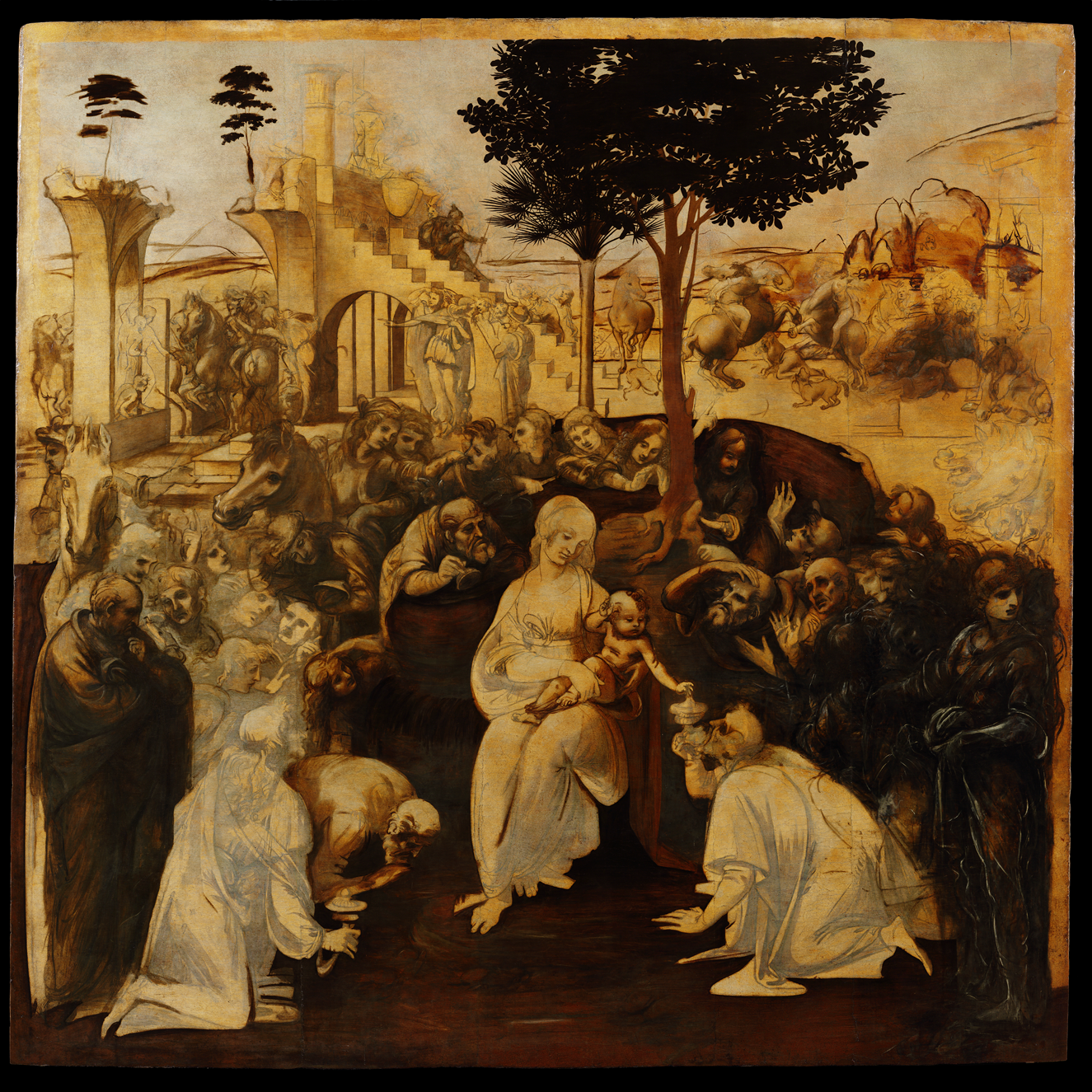
Figure 1. Leonardo da Vinci. Adoration of the Magi, ca. 1482. Galleria degli Uffizi, Florence. © Su concessione del Ministero della Cultura—Galleria degli Uffizi di Firenze.
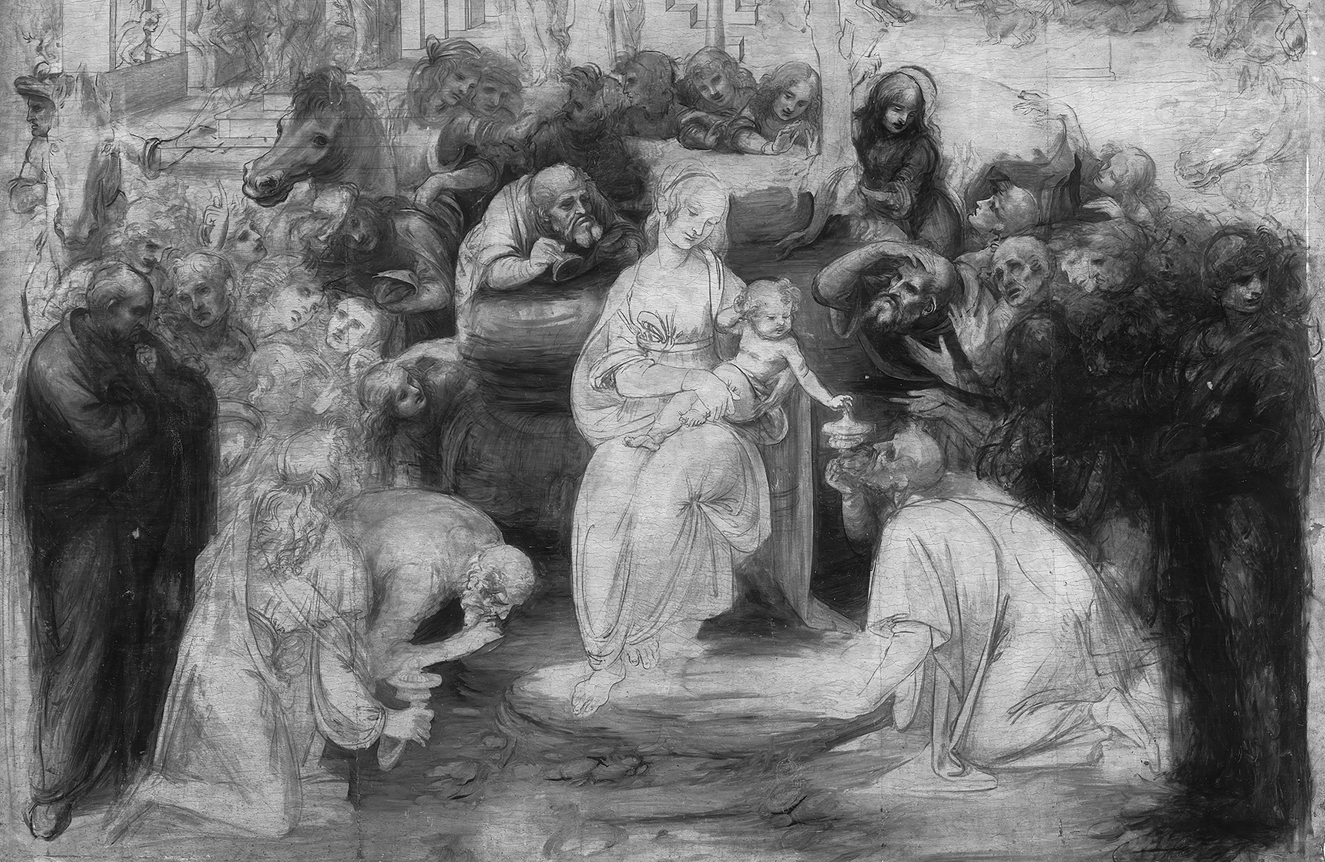
Figure 2. Infrared photography of Leonardo da Vinci, Adoration of the Magi. © Su concessione del Ministero della Cultura—Opificio delle Pietre Dure di Firenze.
Leonardo's drawings have been analyzed with various techniques as well. Alan Donnithorne examined a selection of drawings from Windsor Castle and, with the help of macrophotography, showed how Leonardo moved from his initial sketches in metalpoint to his reworkings and retracing in red and black chalk, in pen and ink, or with washes and other metal points. Benedetta Spadaccini did the same for thirty drawings from the Ambrosiana. The Uffizi had Leonardo's 1473 Landscape examined anew with infrared (fig. 3); the new images, which are published in a volume edited by Roberta Barsanti, revealed two distinct phases of execution and helped to clarify the drawing's interpretation as an intellectual speculation by the artist rather than a topography of a distinct place.
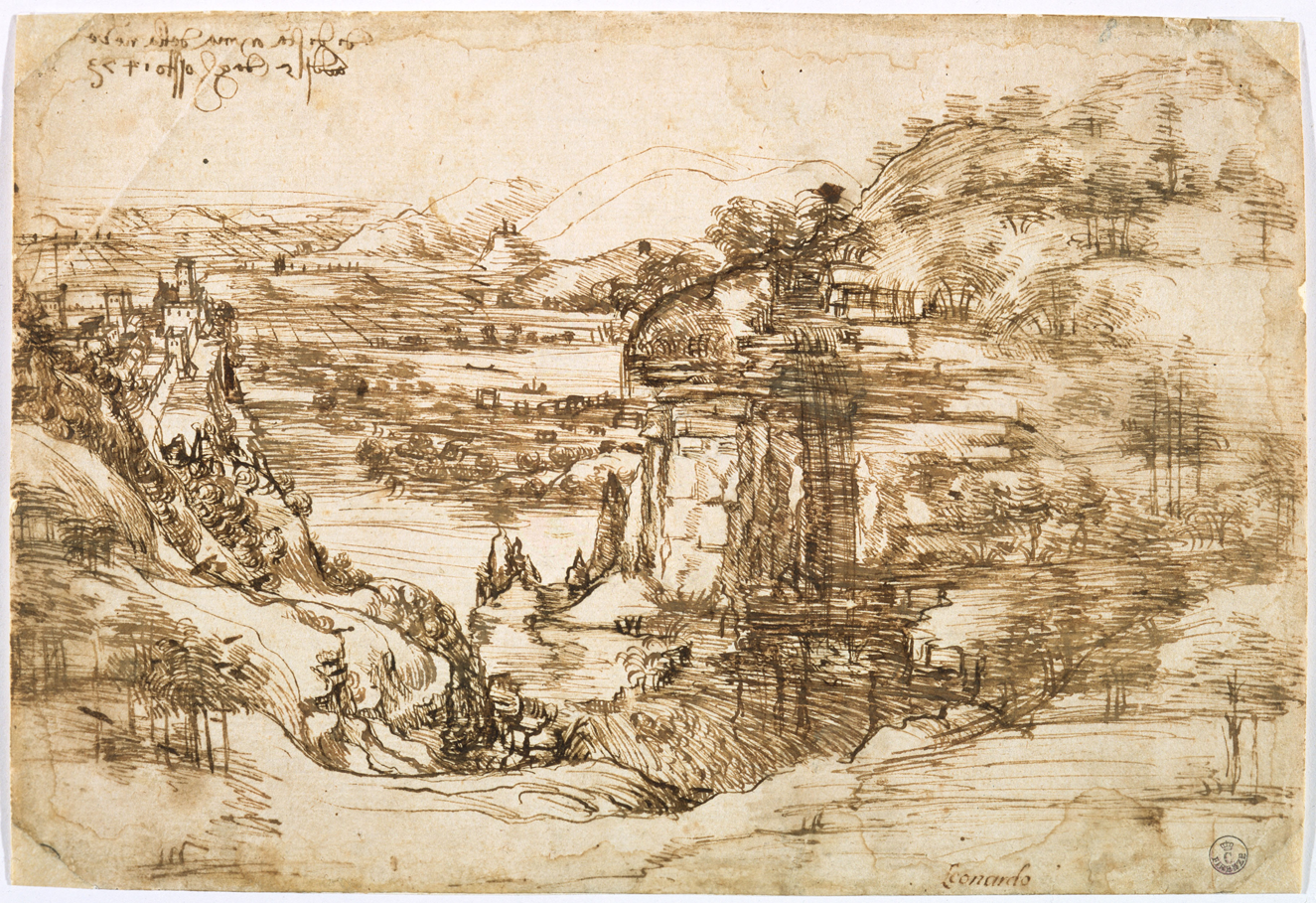
Figure 3. Leonardo da Vinci. Landscape of the Arno River and Valley, 1473. Gabinetto dei Disegni e delle Stampe degli Uffizi, Florence. © Su concessione del Ministero della Cultura—Galleria degli Uffizi di Firenze.
Once the exclusive domain of conservators and used predominantly by connoisseurs to settle matters of attribution, this new archive made possible by advanced technology has become an essential part of mainstream art history. This new state of affairs was exemplified by the courageous choice of the Louvre exhibition's curators to frame infrared and X-ray photographs of Leonardo's famous paintings and display them next to the actual paintings, modern images and original works all at the same size. The message for the public was unequivocal: just like curators form their opinions on Leonardo's works based on those images, so should the wider public form theirs.
Kenneth Clark, who knew Leonardo's work deeply, regarded Leonardo's writings as “a vast accumulation of words” that were a distraction for scholars interested in his art.Footnote 3 But others have come to appreciate the over 4,000 folios that arrived to us, which are only a portion of what Leonardo wrote in his lifetime. By a conservative estimate he must have written twice as much—some 8,000 pages. A more liberal estimate would give us 16,000 pages. No other artist or author from the Renaissance left a similar output. And no artist had a more idiosyncratic and fragmentary form of writing, which is why the critical study of Leonardo's written legacy can be exemplary to the legacy of other artists and authors.
Facsimiles, transcriptions, and critical editions have helped greatly in the interpretation of these fragmentary notes. Now Leonardo's writings are available digitally, which helps to overcome the problems of Leonardo's manuscripts being hardly available for direct study and few libraries owning the rare and expensive facsimile editions that have been published in the past century. For the anniversary year, the Venerabile Biblioteca Ambrosiana put online the entire Codex Atlanticus, a total of 1,119 folios, enriching the experience and facilitating its reading with sophisticated enlargement tools, thematic indexes, and color-coded features to group folios dealing with similar topics. Similarly, the Royal Collection Trust, the Victoria and Albert Museum, the Biblioteca National de España, and the Archivio Storico Civico e Biblioteca Trivulziana have made the notebooks in their holdings digitally available, but other repositories limit access to a few pages, as, for instance, the British Library, London, and the Biblioteca Reale, Turin, who own, respectively, the Codex Arundel and the Codex on the Flight of Birds. The most conspicuous case of modest access to Leonardo's notebooks is that of the Bibliothèque de l'Institut de France, which owns twelve manuscripts by Leonardo, for a total of over 1,000 folios: it allows for their consultation only via the website of the Réunion des Musées Nationaux, where, unfortunately, they appear as individual page images so randomly displayed that even an order by manuscript is hard to keep.
A fundamental digital resource for a comparative and topical analysis of Leonardo's written legacy that goes beyond individual notebooks is e-Leo. Created by the late Romano Nanni for the Biblioteca Comunale Leonardiana, Vinci, it makes Leonardo's writings available worldwide, notebook by notebook, page after page, transcription after transcription, while a glossary gives the option of a word search, which helps connect similar topics across manuscripts. The glossary, which has also been published in separate volumes, each volume dedicated to a specific topic (optics, machines, etc.), is in effect a modern version of the anthologies that, from the late nineteenth century onward, assembled the artist's notes thematically, such as those by Richter, Pedretti, and Kemp and Walker.
The recent scholarship of Carlo Vecce and Carmen Bambach has put us in a much better position than a few decades ago to understand not only what topics Leonardo wrote about but how he wrote about them. Bambach has a thorough discussion of Leonardo's notebooks, their bindings, and physical evidence in her Leonardo da Vinci Rediscovered, while Vecce studies how the artist read books in his La biblioteca perduta, a study that became an exhibition titled Leonardo e i suoi libri, and in the collective volume he edited, La Biblioteca di Leonardo. Thanks to their work we now have a clearer understanding of how Leonardo wrote and revised his writings.
Leonardo liked to carry around pocket-size notebooks to “record with rapid notations”Footnote 4 the movements and actions of people he met in the streets, to jot down his thoughts as he traveled, or to copy interesting passages from the books he read (fig. 4). He made these small notebooks by folding large folios into eighths, although sometimes he bought small ready-made notebooks from the stationery shops. Periodically he put his writings in order. Working at his desk, he spent days and days flipping through the mess of disorganized pages he had accumulated over the years, going over them, selecting the best notes and sketches among the many he had originally jotted down in no particular order, and regrouping them according to specific topics—optics, anatomy, water, mechanics, cosmology, etc. Then he copied the selected passages in sets of new folios. For these reorganized folios, he preferred a larger format, which he achieved by folding the folios into four parts. In some exceptional cases, when he planned to copy larger and more-detailed diagrams or longer texts, he folded the folios only in half (Manuscript C and the Codex Leicester are the only large notebooks that arrived to us) (fig. 5). He planned the layout of these new folios with great care, often spacing the drawings elegantly and proportionally and adjusting the accompanying texts to the shape and size of the diagrams. Usually, he did not bind these folios, as it was easier for him to write on loose sheets. He simply gathered them inside one another, put a cover around them, and closed them with a clutch or a rope. Sometimes he numbered the pages. More often he did not.
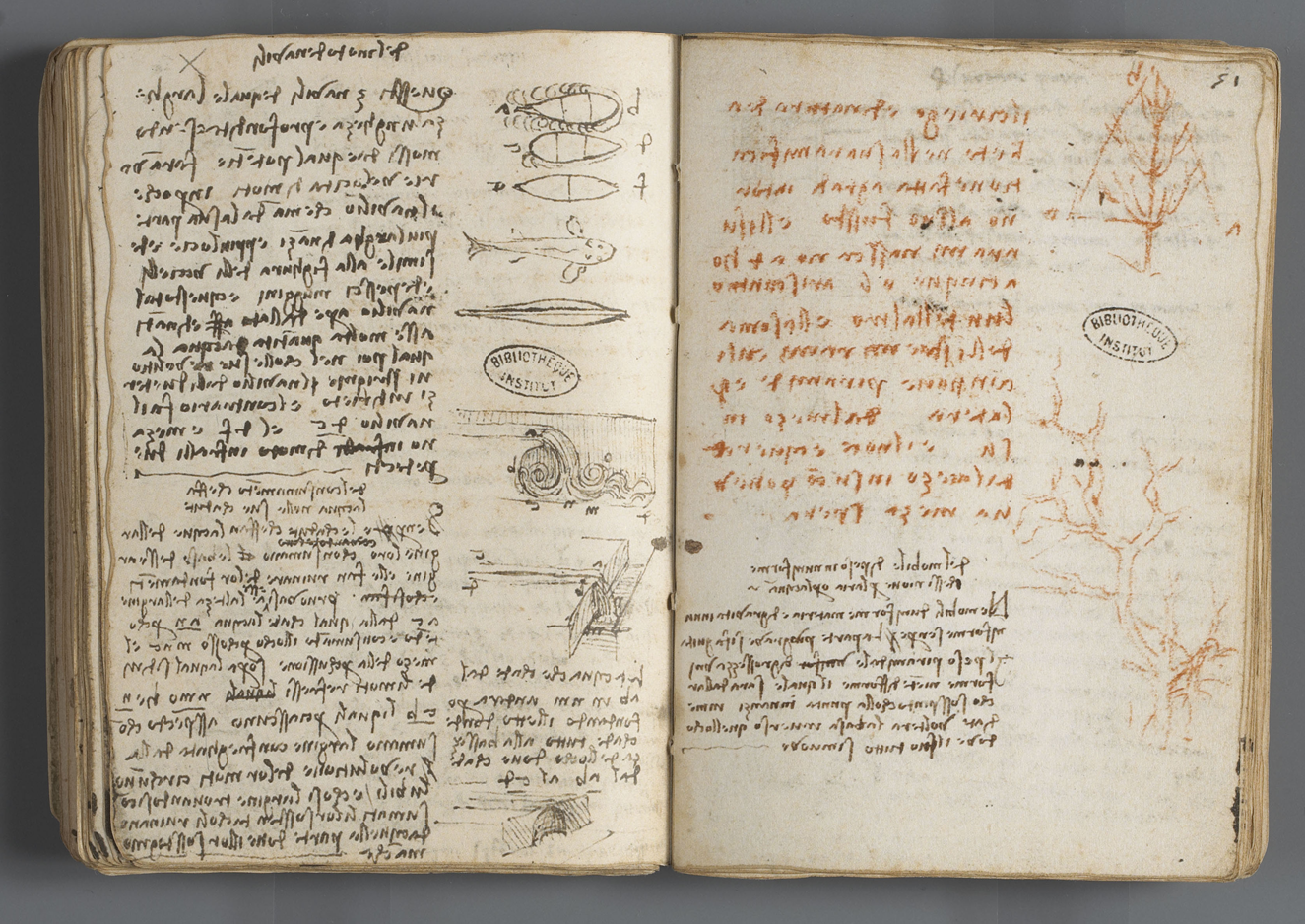
Figure 4. Leonardo da Vinci. Manuscript G, ca. 1510–15. Bibliothèque de l'Institut de France, Paris, cod. 2178, fols. 50v and 51r. © RMN (Institut de France) / Art Resource, NY.

Figure 5. Leonardo da Vinci. Manuscript C, ca. 1490–91. Bibliothèque de l'Institut de France, cod. 2174, fols. 18v and 19r. © RMN (Institut de France) / Art Resource, NY.
Bambach and Vecce clarified that in Leonardo's notebooks we do not find well-rounded arguments or coherent sequences of thoughts, as Leonardo wrote incessantly but inconclusively and, ultimately, did not finish any of the books he planned. Instead, we find drafts at various levels of elaboration, and our job as scholars is to ask systematically what it is that we are reading: Is it a passing thought Leonardo jotted down while on the move? Or a passage he copied from a book that caught his attention? Or an early reworking of his own thoughts? Or a highly advanced draft? Bambach and Vecce have taught us to determine what it is that we are reading by combining textual analysis with the physical evidence of the folios, the artist's handwriting, the ink and paper he used, and, above all, the layout of each page.
Modern technology can help us take the next step in Leonardo studies. The digital environment has the potential of enhancing considerably the comparative analysis of Leonardo's written legacy. Going beyond traditional printed anthologies and current digital publications, advanced technology makes it possible to share with a broad range of scholars in various disciplines and with general readers the most updated knowledge concerning writings by Leonardo that have, until now, been the exclusive purview of a restricted group of specialists. It facilitates the study of Leonardo's notebooks as a whole in ways that are independent from their current ownership and physical status but more attuned with the way Leonardo kept them on his desk.
Let me explain: most of Leonardo's notebooks do not have their original bindings or their original order (however scattered that order was). Rather, they have bindings that were imposed by others after Leonardo's death. But it is according to their current state of binding and ownership that Leonardo's writings are cataloged, studied, and made available digitally and in print. Unfortunately, as helpful as these efforts are to make Leonardo's writings accessible worldwide, they hinder instead of facilitating an understanding of his thought processes and his way of writing by remaining narrowly focused on the current ownership and binding of each individual notebook. Ultimately, they are not concerned with the preservation, study, and understanding of Leonardo's legacy.
In the digital environment, it is possible to analyze systematically Leonardo's writings on the basis of how he wrote and kept his papers. The difficulty resides in imagining a new way of collaboration among different constituencies, from the private and public institutions that keep Leonardo's writings to the publishers who print them and the scholars who create critical editions.
One bright spot of the next level of scholarship is the recent agreement between the Museo Galileo and the Royal Collection Trust to create the project Leonardo//thek@. Modeled on the project Galileo//thek@, it aims to create an integrated and searchable digital platform of Leonardo resources. At the moment, the project involves the Codex Atlanticus and the holdings at Windsor Castle, a group of over 1,500 folios that, after Leonardo's death, were rearranged in two large albums by the sculptor Pompeo Leoni (these albums have been disassembled in recent years). When completed, the integrated archive will make it possible to compare folios from these two vast repositories and get closer to the way Leonardo wrote and kept them.
One wonders if this partnership may become a model for an overall project that would aim to publish Leonardo's written legacy in the forms of the twenty-first century. Perhaps individual repositories and publishers may overcome institutional divides and restrictive copyright laws and come to an understanding on sharing facsimile images, transcriptions, and critical apparatuses for this common purpose. Perhaps a foundation would be willing to fund such a project. And perhaps the Commissione Vinciana, a committee that was created by the Ministry of Education to oversee Leonardo's legacy and that coordinated the initiatives for the anniversary year, may supervise such an ambitious project.
Moreover, the digital environment presents unique opportunities to bring together not just the notebooks but also the drawings, the paintings, the archival sources documenting his life, the technical analysis explaining his works, and the scholarship illuminating his art and thought. The digital environment also allows us to communicate the artist's intricate thought and art, beyond a select group of experts, to the widest possible range of publics worldwide, a task that seems as urgent as ever in the current historical moment.
Leonardo studies from past decades and those published for the 500-year anniversary have reaffirmed how Leonardo looked for similarities among things that are apparently unrelated. He made sense of different phenomena by visualizing complex information, complex bodies of knowledge, and complex interrelations between humans and nature. He explored large amounts of abstract data from geology, hydraulics, philosophy, physics, and optics, and put them together in images and diagrams, at times disregarding what he read in books but never dismissing what he saw with his eyes. His anatomical tables were perhaps the most consequential: they made visible the hidden human body in ways that still inform how we represent it today. Anatomy was the scaffolding of what he called “the representation of man and the intention of his mind,”Footnote 5 but what he really meant was our human impulse to represent the self, and to consider our bodies and surroundings and people around us with abstraction and meaning. And this is what has mattered to us as humans since the beginning of time.
His wish was to reveal deeper truths about the human condition, a fact that we tend to forget when we praise him as the genius who imagined inventions that would not come to exist until centuries later, from the parachute to the flying machine. But what continues to elicit our gasps half a millennium after his death is the way he painted men and women: he captured their psychological depths because, to him, science and art were one and the same. By putting his works in such a gilded frame, we sometimes fail to see that for him painting was a thought process that integrated art and science to reveal the human soul. And this is possibly what most connects him to our current age, and what makes the study of his legacy so crucial: his synthetic way of thinking, an approach that was and still is at the root of innovation in any field, but that has become increasingly difficult to achieve because of highly specialized disciplinary training and expertise that has separated art from science.
The distinction between art and science did not apply to Leonardo, as in the Renaissance disciplines were not formed yet, and there was only one culture for discovery, experimentation, and innovation. There are plenty of good reasons for the creation of distinct disciplines and specific expertise, but this siloed knowledge is becoming less and less apt for addressing the intractable problems of our day. Whether we are dealing with immigration, race, the environment, health, inequality, or global communication, we need to be able to look at issues from a variety of perspectives, through different lenses, with comprehensive and comparative approaches that facilitate understanding. In our age of big data, digital communication, and visual immersion, as we wrestle with finding the most effective ways to educate the next generation of citizens and innovators, Leonardo's approach to innovation via art and science is highly significant.
There have been attempts to return to the culture of transdisciplinary innovation that marks Leonardo and his achievements. In 2018, the National Academies of Sciences, Engineering, and Medicine published a report, which they titled Branches from the Same Tree, after Albert Einstein's famous quotation, to urge the support of “courses and programs that integrate the arts and humanities with the natural sciences, social sciences, technology, engineering, mathematics, and medicine in higher education.”Footnote 6 Although no comprehensive evidence of learning outcomes is available yet, there is enough to suggest that these programs effectively train students in twenty-first-century skills that the report identifies as “critical thinking, teamwork, communication skills, ethical reasoning, creativity, and lifelong learning attitudes.” These are the skills “employers are calling for and that will serve students in life and citizenship.”Footnote 7 The National Academies convened national leaders to encourage colleges and universities to create integrated approaches to education that go beyond the traditional liberal-arts curriculum.
Even the financial sector is paying attention. Recently, Bill Miller, chairman and chief investment officer of the fund Miller Value Partners, credited his success as an investor to his graduate training in philosophy: “The critical reasoning and analytical skills that are essential in philosophy proved to be enormously useful to me in my investment career,” he noted in an interview, adding that “the ability to think holistically, with a critical eye, has been critically important to me in terms of thinking through the markets.”Footnote 8
Ours is a more complex world than that of the Renaissance; returning to those days is neither possible nor necessarily desirable, and there are aspects of Leonardo's approach that it may be good to leave behind. For one, we value outcomes, whereas he finished very little. Even the Mona Lisa is not finished. Nor do we miss the politics, the social norms, and the gender and racial relations of the period in which he lived. But Leonardo's approach to art as the core for generating transformative conceptual frameworks may still be relevant. In fact, Leonardo studies and Renaissance studies, more broadly, are in a privileged position to show future generations that art, science, and technology shared common histories, principles of order, and methods of inquiry, and that those past interactions may be as relevant as ever in our historical moment.
In our current age, as our communication is increasingly digital and our behavior gradually reduced to sets of big data, it is as relevant as ever to consider connections among apparently unrelated data and what those connections might reveal about human behavior. As we struggle for more and more empathic responses toward one another, it is important to be reminded that the aesthetic realm of art and science not only broadens our understanding of the human experience but is the realm where we create what does not exist yet, the indispensable space of discovery where we learn about the complexity of human nature and imagine new, more equitable ways of interaction.



